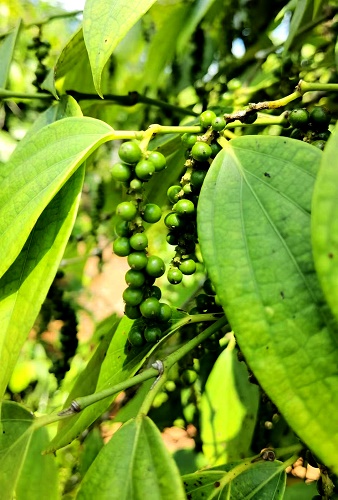Order: Piperales
Family: Piperaceae
General Overview: Piper nigrum, commonly known as black pepper, is a flowering vine in the family Piperaceae, native to the Indian subcontinent and Southeast Asia. It is now cultivated in various tropical regions around the world, including India, Indonesia, Vietnam, and Brazil.
Morphological Features: The plant has a woody vine that can grow up to 4 meters in height and spreads readily, rooting where the stems touch the ground. Its leaves are 5 to 10 cm long and 3 to 6 cm wide, and its flowers are small and produced on pendulous spikes that lengthen up to 15 cm as the fruit matures. The fruit of Piper nigrum is a small, spherical drupe that turns from green to red when ripe.
Biological Characteristics: Piperales are recognized for their distinctive phytochemistry, particularly the presence of unique piperidine alkaloids. Piperine, the predominant alkaloid, contributes significantly to the pungency and flavor profile of black pepper. Beyond its culinary applications and use as a preservative in meat products, black pepper has found extensive utilization in traditional medicinal systems, such as Ayurveda, traditional Chinese medicine, and folk medicines in Latin America and Southeast Asia.Piperine exhibits diverse pharmacological activities, including the modulation of fat cell differentiation through the downregulation of peroxisome proliferator-activated receptor (PPAR) gamma expression. This property positions piperine as a potential therapeutic agent for diabetes, acting as a PPAR agonist. Additionally, piperine demonstrates antioxidant, antitumor, antimicrobial, antidepressant, and anti-inflammatory attributes. In addition to its culinary and medicinal uses, black pepper is also used in various industrial applications, such as in the production of perfumes, soaps, and insecticides. Overall, Piper nigrum is a versatile and important plant with a long history of use in various cultures around the world. Its unique flavor and aroma, as well as its numerous health benefits, have contributed to its enduring popularity.

